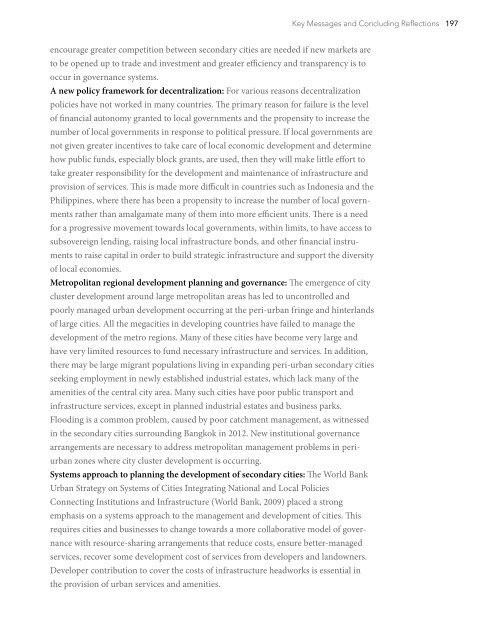DYhWN
DYhWN
DYhWN
You also want an ePaper? Increase the reach of your titles
YUMPU automatically turns print PDFs into web optimized ePapers that Google loves.
Key Messages and Concluding Reflections 197encourage greater competition between secondary cities are needed if new markets areto be opened up to trade and investment and greater efficiency and transparency is tooccur in governance systems.A new policy framework for decentralization: For various reasons decentralizationpolicies have not worked in many countries. The primary reason for failure is the levelof financial autonomy granted to local governments and the propensity to increase thenumber of local governments in response to political pressure. If local governments arenot given greater incentives to take care of local economic development and determinehow public funds, especially block grants, are used, then they will make little effort totake greater responsibility for the development and maintenance of infrastructure andprovision of services. This is made more difficult in countries such as Indonesia and thePhilippines, where there has been a propensity to increase the number of local governmentsrather than amalgamate many of them into more efficient units. There is a needfor a progressive movement towards local governments, within limits, to have access tosubsovereign lending, raising local infrastructure bonds, and other financial instrumentsto raise capital in order to build strategic infrastructure and support the diversityof local economies.Metropolitan regional development planning and governance: The emergence of citycluster development around large metropolitan areas has led to uncontrolled andpoorly managed urban development occurring at the peri-urban fringe and hinterlandsof large cities. All the megacities in developing countries have failed to manage thedevelopment of the metro regions. Many of these cities have become very large andhave very limited resources to fund necessary infrastructure and services. In addition,there may be large migrant populations living in expanding peri-urban secondary citiesseeking employment in newly established industrial estates, which lack many of theamenities of the central city area. Many such cities have poor public transport andinfrastructure services, except in planned industrial estates and business parks.Flooding is a common problem, caused by poor catchment management, as witnessedin the secondary cities surrounding Bangkok in 2012. New institutional governancearrangements are necessary to address metropolitan management problems in periurbanzones where city cluster development is occurring.Systems approach to planning the development of secondary cities: The World BankUrban Strategy on Systems of Cities Integrating National and Local PoliciesConnecting Institutions and Infrastructure (World Bank, 2009) placed a strongemphasis on a systems approach to the management and development of cities. Thisrequires cities and businesses to change towards a more collaborative model of governancewith resource-sharing arrangements that reduce costs, ensure better-managedservices, recover some development cost of services from developers and landowners.Developer contribution to cover the costs of infrastructure headworks is essential inthe provision of urban services and amenities.


